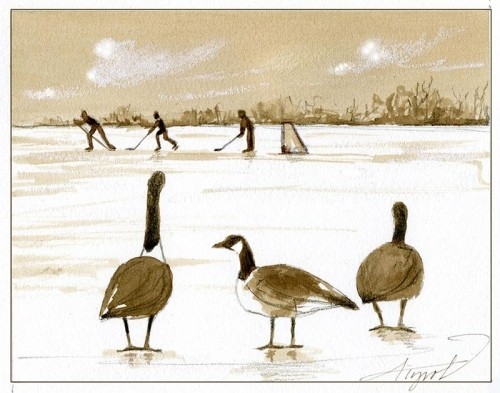
My favorite season tends to be whatever comes next, which means, for now, deep winter. With our storm windows installed and four tons of wood pellets put up, I'm feeling smug as the ant in Aesop's fable. But what about the furred and feathered creatures out there in the cold? When I imagine a Canada goose on an icy pond, or a white tail knee deep in the white stuff, it makes me shiver and wonder: How do warm-blooded animals stay warm?
Back in the olden days when I was a kid, the first thing we did to make sense of whatever scurried, hopped, or slithered across our path was to lump it into one of two animal persuasions – either warm- or cold-blooded.
The cold bloods were always reptiles, amphibians, and fishes. As far as we knew, they lived more or less at the whim of the environment, choosing sunny spots in which to laze and burrowing deep in dens or mucky bogs to sleep through the harsh winter extremes. Meanwhile, the crafty warm bloods somehow maintained a cozy body temperature and went about their lives in high gear.
This rudimentary classification scheme has long since fallen out of scientific favor. Not only have multiple exceptions been discovered (e.g., tuna and sea turtles with toasty internal temps that defy the chilly seas) but we’ve also learned that even the warm bloods aren't always warm blooded.
Consider that Canada goose on the icy pond. While she's standing there, cooling her heels and keeping an eye out for predators, a metabolic fire burns within her belly. Food and fat are converted to heat, and the warmth is distributed by her circulatory system.
But like most endotherms, our goose has a trick up her legs – a miraculous cardiovascular adaptation called a rete mirable. (Translated: "wonderful net.") A rete is a vascular structure where multiple outgoing capillaries run parallel to a meshwork of inbound vessels draining the extremities. The juxtaposition of opposing flows creates a countercurrent heat exchanger, where the warm outgoing blood heats the frigid incoming blood and vice versa. It's a miraculous switcheroo where a decidedly warm-blooded animal becomes, in effect, cold-blooded. The result: only a fraction of the heat generated under the goose’s downy coat is lost to the icy external environment, while her feet and toes are kept just above freezing.
But, as it turns out, staying warm is only half the battle – hyperthermia can be as much of a problem for cold-adapted animals as hypothermia. For instance, if our goose is forced to exert herself, say in a dash to escape a fox, she runs the serious risk of overheating. The central nervous system is exquisitely temperature sensitive; convulsions, seizures and death can result from even a few degrees increase in body temperature. At a sublethal level, the proteins that catalyze virtually every enzymatic reaction (from muscle contraction to burning glucose) are highly temperature dependent. Go a couple degrees above their homeostatic norm and performance plummets – Mr. Fox gets a tasty dinner.
So how does the goose avoid getting cooked? She relies on a second, equally wonderful cardiovascular feat, the arteriovenous anastomosis (AVA).
AVAs are vascular bypasses where smooth muscle valves can open to shunt hot blood to veins near the body's surface, and thereby shed heat into the atmosphere. In other words, they are biological radiators. AVAs can be found throughout the animal kingdom: in the footpads, ears, noses and muzzles of black bears, in the fins and flukes of dolphins, in the feet of waterfowl. If we pointed an infrared heat gun at our imaginary fox, fresh from his failed attempt to catch the goose, we’d see a white-hot nose, eyes, and ears on a background of cool blue fur.
Whether you enjoy the winter like I do, or the thought of it makes your blood run cold, take a moment to appreciate the complexity of the wonderful net beneath an animal’s skin.

